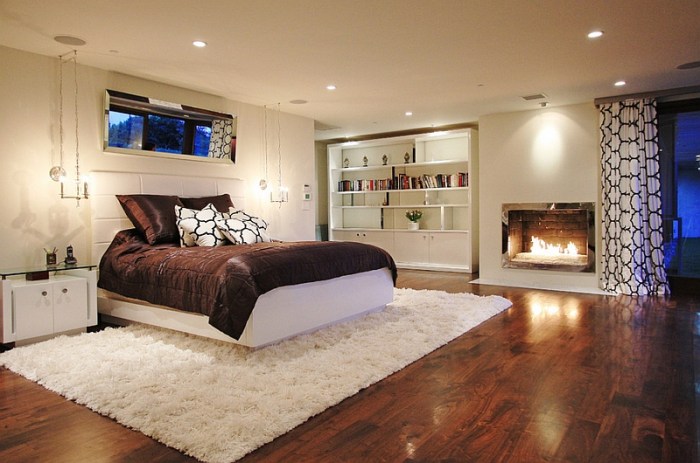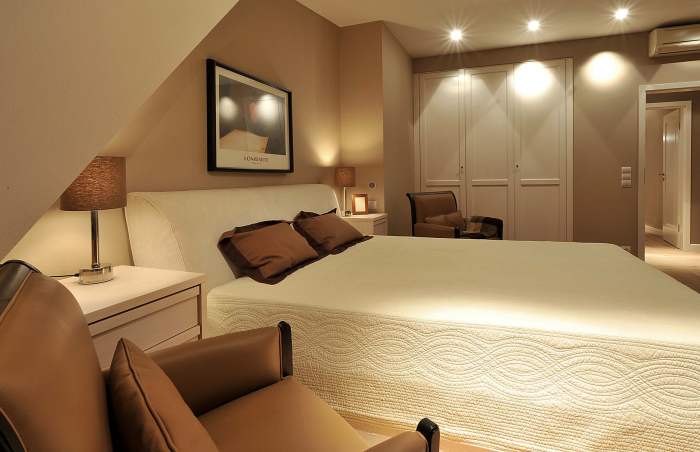Basement Bedroom Space Optimization

Basement bedroom design ideas – Transforming a basement into a comfortable and functional bedroom requires careful planning and efficient space utilization. Low ceilings and limited natural light often present unique challenges, but with thoughtful design, a basement bedroom can be both stylish and practical. This section explores various layout options, closet designs, and solutions for low ceiling issues.
Basement Bedroom Layout Options for Small Spaces
Effective space planning is crucial in a small basement bedroom. The following five layouts prioritize maximizing usable area and ensuring smooth traffic flow. Each option considers furniture placement and functionality.
- Layout 1: The Murphy Bed Solution: This layout features a Murphy bed, which folds away into the wall during the day, maximizing floor space. A small desk or vanity can be placed opposite the bed, with a narrow walkway between. A chest of drawers can be positioned against one wall. This design is ideal for maximizing daytime space and creating a multi-functional room.
- Layout 2: The Platform Bed Approach: A low platform bed takes up less visual space than a traditional bed frame. Nightstands can be slim and wall-mounted to save floor space. A small dresser and a wardrobe can be placed along one wall, creating a streamlined look. This approach prioritizes simplicity and minimalism.
- Layout 3: The Loft Bed Design: A loft bed elevates the sleeping area, freeing up valuable floor space underneath for a desk, seating area, or storage. A ladder provides access to the bed. This is an excellent option for maximizing vertical space in rooms with higher ceilings.
- Layout 4: The Corner Bed Arrangement: Positioning the bed in a corner allows for more flexible placement of other furniture. A small desk can be placed near a window for natural light, while a wardrobe can be placed against the opposite wall. This layout creates a cozy and intimate feel.
- Layout 5: The Multi-Functional Furniture Strategy: This layout utilizes furniture with built-in storage, such as an ottoman with storage or a bed with drawers underneath. This design helps minimize clutter and keeps the room organized. A wall-mounted shelving unit can provide additional storage.
Compact Closet System Design, Basement bedroom design ideas
A well-designed closet system is essential for maintaining organization in a small basement bedroom. This design focuses on maximizing storage within a limited footprint.The proposed closet measures 4 feet wide by 2 feet deep by 7 feet high. It incorporates adjustable shelving, double hanging rods, and drawers. The lower section features three deep drawers for folded clothing and linens, each measuring 2 feet wide, 2 feet deep, and 1 foot high.
Above the drawers, a double hanging rod allows for both long and short garments. Adjustable shelving units above the hanging rods provide space for folded items, shoes, and accessories. The shelving units are approximately 1 foot deep and have adjustable heights to accommodate varying storage needs.
Image Description: The closet is imagined as a modern, minimalist design using light-colored wood (e.g., birch) for the shelving and drawers. The hanging rods are brushed nickel for a sleek, contemporary look. The overall aesthetic is clean and uncluttered, enhancing the sense of spaciousness within the small closet.
Designing a basement bedroom can present unique challenges, but also exciting opportunities for creativity. For instance, incorporating vibrant colors and rich textures can transform the space. If you’re looking for inspiration, consider the warmth and character found in mexican bedroom design ideas ; their use of bold patterns and earthy tones can easily be adapted to a basement setting, creating a cozy and inviting atmosphere.
Ultimately, the goal is to maximize natural light and create a space that feels both comfortable and stylish.
Addressing Low Ceiling Challenges in Basement Bedrooms
Low ceilings are a common challenge in basement bedrooms. Several strategies can mitigate this issue and create a more comfortable space.
- Light Colors: Painting the walls and ceiling in light, reflective colors helps to visually expand the space and make the room feel less cramped. Avoid dark or bold colors which can make the room feel smaller and darker.
- Mirrors: Strategically placed mirrors can create an illusion of more space and reflect light, brightening the room. A large mirror on one wall can dramatically increase the sense of openness.
- Minimalist Furniture: Opting for low-profile furniture, such as a platform bed or low-slung seating, helps to prevent the room from feeling overwhelmed and maintain a sense of height.
- Vertical Space Maximization: Utilizing vertical space with tall, narrow shelving units or a loft bed maximizes storage and minimizes the impact of low ceilings.
- Recessed Lighting: Recessed lighting helps to create a sense of height by directing light upwards, rather than using bulky pendant lights that hang down from the ceiling.
Basement Bedroom Decor and Style

Transforming a basement bedroom from a dark, damp space into a cozy and inviting retreat requires careful consideration of decor and style. The right design choices can dramatically impact the overall feel of the room, maximizing its potential and creating a comfortable personal sanctuary. Choosing a style that complements the existing architecture and your personal preferences is crucial for achieving a successful design.
Modern Minimalist Basement Bedroom
This style prioritizes clean lines, functionality, and a neutral color palette. Think calming greys, crisp whites, and subtle charcoal accents. Materials like polished concrete (if appropriate for the basement), sleek wood, and glass create a sophisticated and uncluttered aesthetic. Furniture should be simple and multi-functional, perhaps a platform bed with built-in storage, a minimalist desk, and a simple wardrobe.
Avoid unnecessary clutter; less is definitely more in this style.
Mood Board Description: The mood board would showcase smooth textures like polished concrete and linen bedding, with a monochromatic color scheme punctuated by the occasional metallic accent. Geometric patterns might be subtly incorporated in throw pillows or rugs, maintaining the overall sense of order and simplicity. The overall aesthetic is serene and calming, reflecting the minimalist ethos.
Rustic Chic Basement Bedroom
This style embraces natural materials and a warm, inviting atmosphere. Think warm browns, creamy beiges, and deep greens. Incorporate reclaimed wood, exposed brick (if present), and natural textiles like wool and linen. Furniture could include a solid wood bed frame, a cozy armchair, and a rustic wooden dresser. Adding elements like a faux fireplace or strategically placed lighting can further enhance the cozy ambiance.
Mood Board Description: The mood board would emphasize natural textures like woven textiles, rough-hewn wood, and possibly stone. The color palette would be warm and earthy, with subtle variations in tone. Patterns would be organic and understated, perhaps a subtle plaid or a distressed wood grain. The overall aesthetic is inviting, comforting, and reminiscent of a cozy cabin.
Eclectic Basement Bedroom
This style celebrates individuality and a mix of styles and patterns. The color palette can be more vibrant and playful, incorporating a variety of hues that complement each other. Materials can range from vintage finds to modern pieces, creating a unique and personal space. Furniture can be a mix of styles and eras, as long as they are cohesive in terms of color and overall aesthetic.
This style allows for greater creativity and personalization.
Mood Board Description: The mood board would be a vibrant collage of textures and patterns, from vintage floral prints to modern geometric designs. The color palette would be eclectic, incorporating bold and unexpected combinations. The overall aesthetic is fun, energetic, and reflective of the homeowner’s unique personality and style.
Five Key Design Elements for a Cozy Basement Bedroom
Creating a cozy and inviting basement bedroom requires attention to detail. The following elements are crucial for achieving a warm and welcoming atmosphere.
These elements work together to counteract the often-perceived coldness and dampness associated with basement spaces, creating a comfortable and inviting retreat.
- Adequate Lighting: Layer lighting with overhead fixtures, bedside lamps, and accent lighting to create a warm and inviting ambiance. Avoid relying solely on overhead lighting, which can be harsh and unflattering.
- Warm Color Palette: Opt for warm, inviting colors like creams, beiges, and soft browns to create a sense of warmth and comfort. Avoid stark whites or cool blues, which can make the space feel colder.
- Soft Textiles: Incorporate soft textiles like plush rugs, cozy blankets, and comfortable bedding to add texture and warmth to the space. These elements create a tactile experience that enhances the feeling of coziness.
- Personal Touches: Add personal touches like photographs, artwork, and plants to make the space feel more like home. These personal elements add character and create a sense of belonging.
- Strategic Placement of Mirrors: Mirrors can help to visually enlarge the space and reflect light, making the room feel brighter and more open. Strategically placed mirrors can significantly improve the overall feel of the room.
Detailed FAQs: Basement Bedroom Design Ideas
How can I improve soundproofing in my basement bedroom?
Consider adding soundproofing materials like acoustic panels to the walls and ceiling. Thick carpeting and heavy curtains can also help absorb sound.
What are some cost-effective ways to improve a basement bedroom’s appearance?
A fresh coat of paint, new lighting fixtures, and strategically placed mirrors can dramatically improve the look of a basement bedroom without breaking the bank.
How do I deal with moisture issues in a basement bedroom?
Ensure proper ventilation with exhaust fans and consider using a dehumidifier to control moisture levels. Addressing any water leaks or seepage is crucial.
Are there any specific building codes I need to be aware of when creating a basement bedroom?
Yes, building codes vary by location but often include requirements for egress windows, fire safety, and electrical wiring. Check with your local building department for specific regulations.
